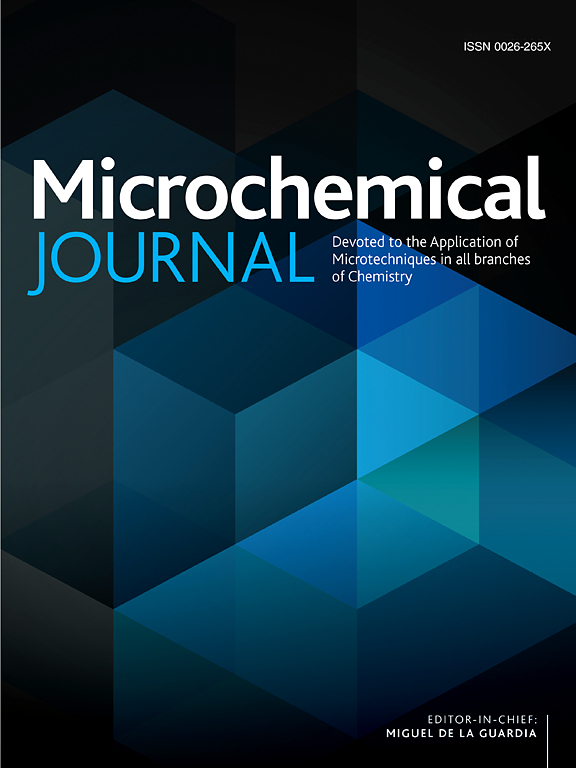Qualitative recognition of waste textiles based on near-infrared spectroscopy and ModernTCN
IF 4.9
2区 化学
Q1 CHEMISTRY, ANALYTICAL
引用次数: 0
Abstract
To address the challenge of online recognition of multi-class waste textiles in their sorting process, the Fabric-ModernTCN, a CNN architecture with strong fabric recognition performance and real-time inference capability, is proposed in this paper. The design of Fabric-ModernTCN is inspired by the state-of-the-art ModernTCN in the field of time series analysis. Using the Fabric-NIR-Dataset, a raw near-infrared spectral dataset including the spectra of 18 categories of fabrics, and its four preprocessed versions generated by applying the standard normal variate transformation, SG smoothing, min–max normalization, and arPLS baseline correction to Fabric-NIR-Dataset, respectively, five categories of Fabric-ModernTCN models are trained, and their recognition performances are evaluated. The most effective preprocessing method, SG smoothing, and its corresponding Fabric-ModernTCN model are selected. Further performance evaluation experiments of this model are conducted, demonstrating its classification accuracy of 93.28 % and F1-score of 94.47 %. The comparative experiments are conducted against two baseline models, InceptionTime and MiniRocket + MLP (MiniRocket coupled with a linear classifier). The results reveal that the Fabric-ModernTCN model outperforms both baseline models across five performance metrics: classification accuracy, precision, recall, F1-score, and inference time per sample. Specifically, the Fabric-ModernTCN model achieves improvements of 2.97 % and 1.82 % in classification accuracy, and 2.52 % and 1.31 % in F1-score, respectively, compared to the baseline models. Regarding computational efficiency, the inference time per sample of the Fabric-ModernTCN model is only 0.0025612 s, corresponding to an FPS of 390.4448, which highlights its strong real-time performance. The ablation experiment results further validate the rationality of the structural design and parameter selection of Fabric-ModernTCN.
基于近红外光谱和ModernTCN的废纺织品定性识别
为了解决多类废旧纺织品分类过程中在线识别的难题,本文提出了一种具有较强织物识别性能和实时推理能力的CNN架构fabric - moderntcn。Fabric-ModernTCN的设计灵感来自于时间序列分析领域最先进的ModernTCN。利用Fabric-NIR-Dataset(包含18类织物光谱的原始近红外光谱数据集)及其对Fabric-NIR-Dataset分别应用标准正态变量变换、SG平滑、最小-最大归一化和arPLS基线校正生成的4个预处理版本,训练了5类Fabric-ModernTCN模型,并对其识别性能进行了评价。选择了最有效的预处理方法SG平滑及其对应的Fabric-ModernTCN模型。对该模型进行了进一步的性能评价实验,结果表明,该模型的分类准确率为93.28%,f1得分为94.47%。对比实验采用了两个基线模型:InceptionTime和MiniRocket + MLP (MiniRocket与线性分类器耦合)。结果表明,Fabric-ModernTCN模型在五个性能指标上优于基线模型:分类准确性、精度、召回率、f1分数和每个样本的推理时间。具体而言,与基线模型相比,Fabric-ModernTCN模型的分类准确率分别提高了2.97%和1.82%,F1-score分别提高了2.52%和1.31%。在计算效率方面,Fabric-ModernTCN模型的每样本推理时间仅为0.0025612 s,对应FPS为390.4448,实时性强。烧蚀实验结果进一步验证了Fabric-ModernTCN结构设计和参数选择的合理性。
本文章由计算机程序翻译,如有差异,请以英文原文为准。
求助全文
约1分钟内获得全文
求助全文
来源期刊

Microchemical Journal
化学-分析化学
CiteScore
8.70
自引率
8.30%
发文量
1131
审稿时长
1.9 months
期刊介绍:
The Microchemical Journal is a peer reviewed journal devoted to all aspects and phases of analytical chemistry and chemical analysis. The Microchemical Journal publishes articles which are at the forefront of modern analytical chemistry and cover innovations in the techniques to the finest possible limits. This includes fundamental aspects, instrumentation, new developments, innovative and novel methods and applications including environmental and clinical field.
Traditional classical analytical methods such as spectrophotometry and titrimetry as well as established instrumentation methods such as flame and graphite furnace atomic absorption spectrometry, gas chromatography, and modified glassy or carbon electrode electrochemical methods will be considered, provided they show significant improvements and novelty compared to the established methods.
 求助内容:
求助内容: 应助结果提醒方式:
应助结果提醒方式:


